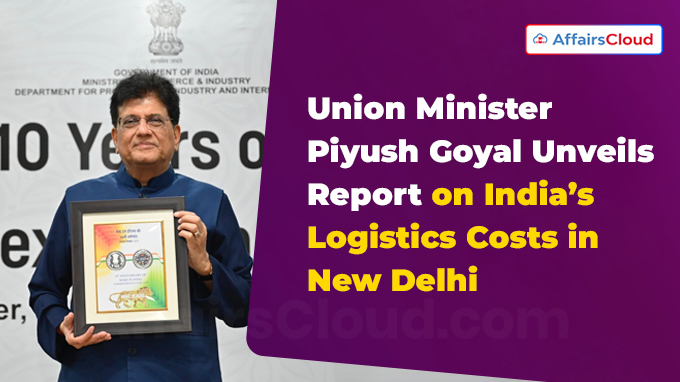 In September 2025, Union Minister Piyush Goyal, Ministry of Commerce and Industry(MoC&I),launched six key initiatives and released a Rs.100 commemorative coin, India’s first-ever coloured coin, to mark the 10th anniversary of the Make in India initiative.
In September 2025, Union Minister Piyush Goyal, Ministry of Commerce and Industry(MoC&I),launched six key initiatives and released a Rs.100 commemorative coin, India’s first-ever coloured coin, to mark the 10th anniversary of the Make in India initiative.
- The six key initiatives are Integrated State & City Logistics Plans (SMILE); Logistics Data Bank 2.0 (LDB 2.0); LEADS 2025 (Logistics Ease Across Different States); Guidebook on Harmonised System of Nomenclature (HSN) Code Mapping; Industrial Park Rating System 3.0 (IPRS 3.0); and a Framework to Estimate India’s Logistics Costs.
Exam Hints:
- What? Launch of 6 new initiatives
- Who? Union Minister Piyush Goyal, MoC&I
- To mark: Make in India 10th Anniversary
- Coin: Rs.100, India’s first coloured commemorative coin
- Key Inititives:
- AoLC: Prepared by NCAER, Cost – 7.97% GDP
- IPRS 3.0: Developed by DPIIT+ADB
- LDB 2.0: tracking platform developed by NLDSL
- LEADS 2025: Evaluates logistics performance of States and UTs
- HSN Codes: Guidelines on mapping released
- S&CLP: Assess existing logistic infra
- Make in India: Launched in 2014, by MoC&I
Overview of Key Initiatives Launched:
Rs.100 commemorative coin :
Coin Details: The Rs.100 commemorative coin weighs 35 gram(g), measures 44 millimeter(mm) in diameter, and is made of a quaternary alloy (50% silver, 40% copper, 5% nickel, 5% zinc) with 200 serrations.
Obverse: Lion Capital of Ashoka with “सत्यमेव जयते” below; periphery shows “भारत” (left), “INDIA” (right), and the Rs.100 denomination with Rupee symbol.
Reverse: ‘Make in India’ emblem, a lion made of industrial tools, symbolizing manufacturing and innovation.
Assessment of Logistics Cost (AoLC) in India Report:
Report: The report provides a framework estimating logistics costs by transport mode, product type, and firm size, including freight cost per tonne‑kilometre (ton‑km).
Prepared By: The report is prepared by NCAER (National Council of Applied Economic Research) for DPIIT (Department for Promotion of Industry and Internal Trade), MoC&I.
- It represents India’s first scientifically derived estimate using a hybrid methodology combining secondary data with nationwide surveys.
Logistics Cost: Previously overestimated at 13–14% of Gross Domestic Product(GDP), India’s logistics costs are now assessed at 7.97% of GDP.
Industrial Park Rating System (IPRS) 3.0:
Objective: The IPRS 3.0, developed by the DPIIT, MoC&I with support from the Asian Development Bank (ADB) aims to further strengthen India’s industrial ecosystem and enhance the competitiveness of industrial infrastructure.
Latest edition: The IPRS pilot phase was built in 2018, followed by IPRS 2.0 in 2021 and now the latest 3.0 edition.
- IPRS 3.0 introduces new parameters like sustainability, green infrastructure, logistics connectivity, digitalization, skill linkages, and tenant feedback, categorizing industrial parks as Leaders, Challengers, or Aspirers based on performance.
Industrial Parks: Union Minister Piyush Goyal noted that the GoI is developing 20 plug-and-play industrial parks and smart cities under National Industrial Corridor Development Corporation (NICDC), with four completed, four under construction, and others in bidding stages.
Logistics Data Bank 2.0 (LDB 2.0):
Objective: The LDB 2.0, developed by NICDC Logistics Data Services (NLDSL) is an enhanced platform for high-seas export container tracking and multi-modal shipment visibility, supporting Micro, Small and Medium Enterprises(MSMEs) and exporters while strengthening India’s digital, transparent, and globally competitive logistics ecosystem.
New feature: LDB 2.0 introduces high-seas container tracking for exporters beyond Indian ports and multi-modal visibility across road, rail, and sea using container, truck, trailer numbers, and railway FNRs (Freight Number Record) through integration with Unified Logistics Interface Platform (ULIP) APIs (Application Programme Interface), enhancing coordination and global credibility.
Logistics Ease Across Different States 2025 (LEADS 2025):
Objective: It is an annual index and survey that evaluates the logistics performance across States and Union Territories (UTs), supporting India’s vision of a globally competitive and future-ready logistics ecosystem.
New Features: The LEADS has introduced 2 major features:
- Performance assessment of 5–7 key corridors based on journey time, truck speed, and waiting periods.
- API-enabled evaluation of section-wise speeds on major road corridors
Harmonized System of Nomenclature (HSN) Codes:
Guideline released: Union Minister Piyush Goyal released the Guidebook on Mapping of HSN Codes, prepared by the DPIIT.
- The Guidebook allocates 12,167 HSN Codes across 31 Ministries and Departments, and is expected to enable targeted policymaking and support effective trade negotiations.
HSN Mapping: Aligning HSN codes with line ministries simplifies sectoral processes, eases business coordination, and boosts India’s trade negotiation stance.
HSN Codes: It was developed by the World Customs Organization (WCO) for the systematic classification of goods all over the world. It is a 6-digit uniform code that classifies 5000+ products and is accepted worldwide.
State and City Logistics Plans (S&CLP):
Plan: The GoI has initiated these plans under the SMILE (Support for Marginalized Individuals for Livelihood and Enterprise) programme in collaboration with the ADB, beginning with eight cities across eight states.
Aim: This exercise will help assess existing logistics infrastructure, identify gaps, and provide a roadmap for improving efficiency and reducing costs.
SMILE : Launched in 2022 by the MoSJE, the scheme provides welfare, rehabilitation, medical care, counseling, education, skill development, and economic support for transgender persons and those engaged in begging.
About Make in India:
Overview: This initiative was launched on 25th September, 2014 to facilitate investment, foster innovation, build best in class infrastructure, and make India a hub for manufacturing, design, and innovation. It is being implemented by MoC&I.
- It focuses on 27 sectors under Make in India 2.0 (15 – manufacturing sectors and 12 – service sectors).
- It is built on 4 foundational pillars: New Processes, New Infrastructure, New Sectors, and New Mindset.
India’s growth: Between 2014 and 2024, India received USD 667 billion (bn) in Foreign Direct Investment (FDI), accounting for nearly two-thirds of all inflows since liberalization.
- India has also made significant progress in ease of doing business, rising from 142nd in 2014 to 63rd in the World Bank’s Doing Business Report (WB-DBR) 2020.
Startup ecosystem: India’s startup ecosystem has grown to over 1.80 lakh DPIIT-recognized startups, making it the third-largest globally after the United States of America(USA) and China, and has generated over 17.6 lakh jobs, with 118 unicorns as of 2025.
About Ministry of Commerce and Industry (MoC&I):
Union Minister – Piyush Vedprakash Goyal (Constituency – Mumbai North, Maharashtra)
Minister of State (MoS) – Jitin Prasada (Constituency – Pilibhit, Uttar Pradesh, UP).




